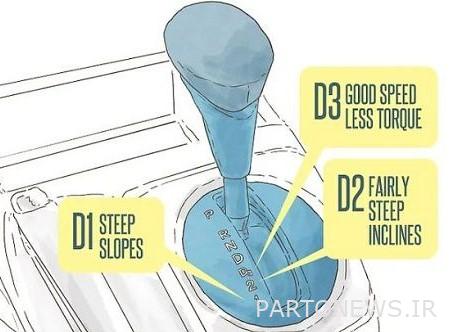How many gears should we cut uphill? / Principles of gear shifting on uphills + photo

According to the online economy report, one of the important issues of driving The principles of gear shifting on uphills is that if it is followed correctly, the car can travel the route with the least possible pressure.
At first, increase the speed as you approach the uphill. If the place is wide, approach the uphill with gear 4 or even 5. Give the car 80% power and stay in 5th gear as long as you can. If you have enough kinetic energy to go uphill, there is no need to change gears. Only your speed should not be dangerous, especially if you are not familiar with the road and the uphill, or especially if you are facing a hill that is going to turn. So you have to be careful. If you know that there is something at the top of the hill, be prepared for it and give less gas.
If the engine has a problem (from the sound of the engine or the car slows down), reduce the gear. When you are going uphill with a car, the car must give more power and energy to the wheels to fight the gravity of the earth and go up.
If the engine howls and screams, the gear is probably too high. You may notice that even though the gear is high and you are constantly pressing the gas, the speed of the car slows down. As soon as you see that the car is slowing down, shift to the lowest gear (3rd or 2nd gear is good) and step on the gas pedal. You should not rush to change gear, but the speed of action in reverse gear is considered an advantage.
Drive fast enough to fit in 3rd gear – the speed varies from car to car, but 30 to 45 mph is good. Change gears quickly to avoid losing kinetic energy. If the engine still cannot go uphill well, shift to 2nd gear. In some situations where the slope is too high, you have to switch to first gear.
Don’t forget that many cars in 1st gear can’t go downhill easily and smoothly. If you haven’t done this before, your car may shake.
Shift up as much as possible to save gas. The higher the gear, the more fuel efficient the car will be. So, raise the gear to save on fuel consumption. Of course, if possible.
At the top of the uphill turn, lower the gear. More power and energy is needed to turn uphill turns. Downshift before entering a turn – put it on 2. In this way, you have the power to turn the corner and maintain that power to climb the hill.
When you are on a slope and want to stop the car, use the handbrake. The handbrake does not allow the car to go back. Pull the handbrake when you stop on a hill or hill. When the light turns green, step on the clutch.
Shift to 1st gear and then slowly take your foot off the clutch. When the clutch is engaged, slowly release the handbrake. Since you are using the handbrake, your foot is free to do the controls that take you up the hill. These controls are clutch and gas. In this case, you have to give more gas to the engine so that the car does not roll back. Gas continuously, but don’t do it all at once. If you take your foot off the gas, the car will jerk back and you may hit an oncoming car.
Driving a car with automatic transmission uphill
But The principles of shifting uphill How about automatic cars? When you drive a car uphill, you need more power than when you drive on a smooth road. A car with an automatic transmission will adjust the gears when going uphill, but at the same time, you still need to make manual adjustments to avoid excessive gear changes.
Using D1, D2 or D3 settings prevents your car from going to higher gears, and as a result, you can use the car’s torque with more tires on the uphill.
Learning to drive uphill, learning to drive uphill, proper gear, moving uphill with a steep slope, important driving knowledge, technical information, automotive knowledge, learning to drive with automatic transmission
D1 (1st gear only): You can use the same lever that you use to shift between Drive, Park and Neutral to shift to 1st gear. Use 1st gear for uphills and low speed. 1st gear also when you use very steep downhills – you can slow down the car with this.
D2 (1st and 2nd gear only): May be marked with 2 or D2. Use D2 mode on relatively high uphills. Also use it to accelerate after going into 1st gear. Gear 2 gives the car more speed than gear 1.
D3 (only gears 1, 2 and 3): Its symbol is 3 or D3. When the car is in D3 mode, it will use only three gears and this will help you when you need to drive at a good speed. But in this case, the engine does not have enough torque to keep the speed in a higher gear.
Use low gear when going uphill. If you want to move at a speed of more than 10 to 15 mph or 16 to 24 km, do not shift to first gear.
Your engine will rev higher than usual so don’t overwork it. A lower gear will apply less pressure and you will have a safer and smoother ride uphill. When you go up a hill, gravity pushes on the car and makes the weight on the engine heavier, so the engine will need more power to turn the wheels. Using a lower gear on an uphill climb will make the engine run at a higher RPM, thus producing the power needed to get uphill without stopping.


